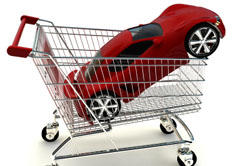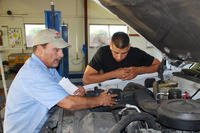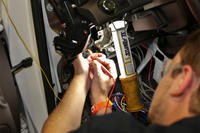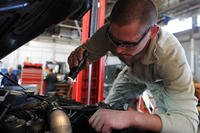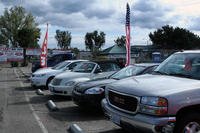Content courtesy of Kelley Blue Book
The time has come to buy a new car -- a decision that involves a ton of decisions and questions to answer. Where do you begin, and how do you go about it? In this new series, we'll take an in-depth look at the ins and outs of buying a new car, and give you tips on how you can get yourself the best deal and the best fit for your needs.
Step 1: Know Your Shopping Style
Even with the large amount of automotive information on the Internet, many people still purchase new cars within only a few days of making the decision to buy. This leaves a huge opportunity for a buyer to be sold a car that he or she may not actually have wanted, rather than making an informed purchase decision to buy a car.
Remember, as the buyer, you should be the one in control throughout the entire process, and you should be making many choices along the way before you even step into a dealership. With so much reliable information available, even if you already have a strong preference about the vehicle you want, take some time to do some research and be open-minded -- you may be pleasantly surprised by the outcome.
Here's one way to start: Take a look at the following list of different types of shoppers and decide which one best describes you. After that, begin your vehicle search by using one of the short cuts shown below, or simply follow all 10 Steps to Buying a New Car to cover all the bases.
Price Shopper
You want the lowest possible price available to get yourself from point "A" to point "B."
Short Cut: Use the Perfect Car Finder to search for a vehicle by price.
Value Shopper
You want a good price, but you are willing to pay for quality.
Short Cut: Check out J.D. Power quality ratings on the vehicles you are interested in.
Image Shopper
You are concerned with what your vehicle says about you. Does it project a desirable image?
Short Cut: Review the top most researched vehicles in the category you're shopping.
Methodical Shopper
You enjoy the chase as much as the conquest, and cover every base, becoming somewhat of a new-car expert.
Short Cut: Go through the entire "10 Steps to Buying a New Car" process.
Safety-Conscious Shopper
You want a safe and reliable vehicle you can trust to keep you and your family safe on the road.
Short Cut: Read about the National Highway Traffic Safety Administration's new Government 5-Star Safety ratings system
Whatever your shopping style, the information you gather and the effort you put into the process will serve you well and help you avoid the buyer's remorse that often accompanies automotive purchases.
Step 2: Narrow Down Your Shopping List, Let Your New Car Find You
With over hundreds of new makes and models available, how do you narrow down your list? To some extent, your lifestyle can help. Imagine the activities you'll experience in your new vehicle. If you have small children, you need something that's roomy enough for everything you have to take with you and is also strong on safety features. Or perhaps you care more about performance or style. If it has to haul or tow something, the choices are pretty obvious.
When considering the purchase of a car, everything counts: Number of seats, number of doors, size, performance, color, style, comfort and sometimes even towing capacity. The key is to narrow your search by creating a short list of choices before ever stepping into a dealership. Where to start? Well, with the convenience of the internet and great sites like kbb.com, easy-to-use decision guides can help you narrow your list of candidates in a short time.
Perfect Car Finder
If you have already determined price range, body style and manufacturer, the Perfect Car Finder is all you need. This three-step series of questions will take you directly to the new and/or used vehicles that fit your requirements, and the tool allows you to view car-pricing reports with specifications, photos, invoice prices, the Manufacturer's Suggested Retail Price (MSRP), options, incentives and rebates.
Side-By-Side Comparisons
Another tool that will help you narrow your search is the Side-By-Side Comparison, which allows you to compare specifications and see which features are standard or optional on each new car. This is an especially helpful exercise when you are down to just a few vehicles and want to compare finer points or features.
Avoid making the common mistake of impulse buying. A minor delay in automotive gratification is worth the time spent, especially when receiving that information from a trusted source.
Step 3: Calculate What You Can Afford, Let Your Budget Do the Driving
When considering a new vehicle purchase, the lines of affordability can easily become blurred due to the varied financing options available. A wise buyer shops for a new vehicle based upon what he or she can truly afford. Keep an open mind and you could be pleasantly surprised by the list of vehicles within your price range.
Affordability is a multi-faceted issue because the car-buying process can consist of several financial considerations. It will help if you determine, accurately and honestly, what your current car is worth, how much of a down payment you can make and a reasonable amount you can handle for monthly payments. Some careful thought and cold, hard honesty will pay big benefits later. Far too many buyers shop for cars that are beyond their budgets, want small down payments, drastically misjudge their capabilities regarding monthly payments and then want to reduce the monthly payments by stretching out the lengths of the loans, all of which leads to trouble in the future.
Another key element is deciding what to do with the current car. As a general rule, it may be worth more to sell it yourself, to a private party, than to trade it in. But many people don't want to take the time and make the effort to do that. You should understand that if you trade it in you will probably not get as much for it as if you sell it yourself.
The biggest issue for most buyers is the price of the new car. Fortunately, determining the MSRP is easy, and figuring at least a range for a realistic transaction price is also not terribly difficult.
Calculating Affordability
The new-car buying process is greatly simplified when you discover the bottom-line vehicle price you can afford ahead of time. This is true whether you lease or buy. Here's an example of the kinds of details that may be involved in a typical new-car deal:
- "The trade-in value of the vehicle I currently own is $10,400."
- "I owe $2,200 on it." Meaning, you have about $8,200 equity in the car.
- "I've got $2,000 in savings I want to put down." Meaning, with the trade, you will be able to give the dealer a total of about $10,200.
- "I want to keep my payments under $400 per month for 60 months." That monthly payment schedule will finance, roughly, about $20,000, meaning the total price of the whole package can be the $20,000 plus the $10,200 you have handed the dealer, or $30,200.? That means a new car in the price range of roughly $27,000, because there will be, generally, about 10 percent added in taxes, license, fees and so forth.
- Furthermore, it means the whole deal, by the time you have paid it off in five years, will have cost you about $34,200 ($400 times 60 months is $24,000, plus the $10,200 you gave the dealer in the form of your trade and the $2,000 down.
This means the same as:
- "I can afford to buy a $27,000 vehicle." And it's going to cost you $34,200 and five years to do it.
There are many online tools available to help you determine affordability.
Your Current Vehicle -- Trade In or Sell Yourself
If your car is in extremely good condition and you have impeccable service records, it may be well worth your while to sell it on your own. On the other hand, if your car needs a lot of work, you may end up putting more money into it than you can recover -- so take a realistic look before you decide.
For trade-in, get the Blue Book® Trade-in Value of your current vehicle. This value -- based upon the condition of your vehicle -- is an accurate representation of what you may expect to be offered when trading in your vehicle at a dealership. If you decide to trade in your vehicle, keep in mind the dealer must assume the responsibility for preparing your trade-in for resale. This process usually includes mechanical and smog inspections as well as repairs to make the car ready to sell to the next owner. This will cost the dealer money, and the dealer will figure this into the deal.
If you would prefer to sell your vehicle to a private party, check out the Blue Book® Private Party value first. This is the value you can expect to get when selling the vehicle to another consumer. In this case, you are solely responsible for preparing your vehicle for sale as well as setting and negotiating a fair price.
Loan Amount
To discover the amount you need to borrow, calculate the monthly payment you can afford via the Kelley Blue Book payment calculator. This tool factors the interest rate and the term of your loan. Now add your available cash with the loan amount and you'll begin to arrive at a price that works for you. Also, check for any customer or dealer incentives that may be available on your new vehicle, adding to your available cash amount. Remember, you still need to add state tax, license and fees, which vary by state and can be obtained through your local DMV.
New Car Pricing
The best news is that new car pricing is now easily accessible online. Kelley Blue Book's kbb.com features three types of new car pricing:
- Invoice Price
The new car pricing report details the invoice price on each trim level. Dealer Invoice is the dealer's cost for the vehicle only and doesn't include any of the dealer's costs for advertising, selling, preparing, displaying or financing the vehicle. - MSRP Price
The MSRP is the Manufacturer's Suggested Retail Price, also known as the "sticker price." This price is required by law to be posted on every new vehicle and is usually -- but not always -- the highest market price. The exceptions occur when certain vehicles are in high demand or have low availability. - Fair Purchase Price Range
Also, check out an available price called Fair Purchase Price. Updated weekly, the experts at Kelley Blue Book have developed the most accurate pricing guidelines for new-car buyers based on purchase data collected across the country.
In addition, incentives may be available on the car of your choice and will bring down the overall price. Current incentives information is easily accessible on kbb.com as well.
Pre-Owned Vehicle Pricing
Your dream car might not be a new car, so you may want to take a look at how a pre-owned model compares to new models within your price range. This unique and helpful feature is exclusive to Kelley Blue Book's Perfect Car Finder, which sorts both new and used vehicles by price range, giving you a complete list of the cars you can afford. You can also compare vehicles side-by-side to further your decision process.
Your decision to stick to a budget will help provide peace-of-mind, both in the car-buying process and in the future. And remember, you're paying more than a dollar for every dollar you borrow, so making a substantial down payment toward the purchase price makes long-term sense. With these principles in place, you should be able to begin in-depth research on your new, shorter list of cars.
[Continued in Part 2]
